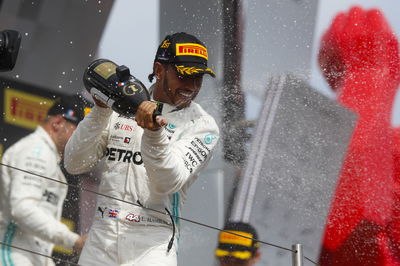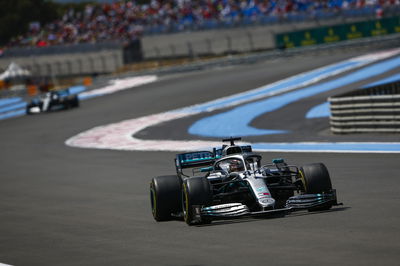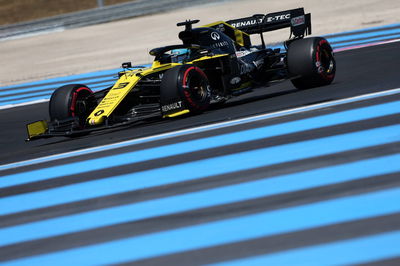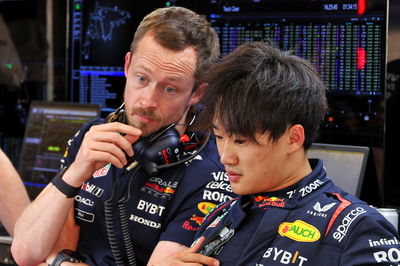F1 Race Analysis: A return to 2019's usual form
Mercedes’ domination of qualifying at Paul Ricard on Saturday proved to be just a taste of things to come in the race as it crushed its Formula 1 rivals once again in the French Grand Prix.
Reverting to its regular form after a two-race dry spell without scoring a one-two finish, Mercedes streaked clear of the field as Lewis Hamilton led home teammate Valtteri Bottas to continue its stunning start to the year. Eight races down, eight wins – and no sign of slowing down any time soon.

Mercedes’ domination of qualifying at Paul Ricard on Saturday proved to be just a taste of things to come in the race as it crushed its Formula 1 rivals once again in the French Grand Prix.
Reverting to its regular form after a two-race dry spell without scoring a one-two finish, Mercedes streaked clear of the field as Lewis Hamilton led home teammate Valtteri Bottas to continue its stunning start to the year. Eight races down, eight wins – and no sign of slowing down any time soon.
Hamilton’s charge to his sixth win of the year and fourth on the bounce was seamless. He led every single lap from pole en route to victory, and only lost the fastest lap bonus point and a sixth career grand slam on the final lap of the race when Sebastian Vettel pipped him to the post.
In fact, the only moment Hamilton looked at even a slight risk of losing the lead came on the second lap, when he had a slight twitch at Turn 4, allowing Bottas to draw to within a second of his teammate at the front. But by the team DRS had been activated, Hamilton had already pulled half a second further up the road, with the gap then only growing in the laps that followed.
Mercedes’ advantage was such that in the early part of the race, Bottas didn’t need to worry about Charles Leclerc sitting in third for Ferrari as he ran around six seconds clear midway through his opening stint. But as his Medium tyres started to fade, so did any hopes of keeping Hamilton within sight at the front as he slipped back at a rate of around half a second per lap. Hamilton reported that his tyres were still holding up OK, with the tipping point for Bottas coming on Lap 22 when he lost 1.6 seconds to Hamilton.
And from then, it was game over. Bottas came in at the end of Lap 23, with Hamilton following suit one lap later. By the time he was back out, the gap was up to 11 seconds.
Hamilton explained after the race that Mercedes was concerned about blisters on his tyres amid high track temperatures at Paul Ricard, and also reported a problem with his seat during the race. He may have said the win “wasn’t easy at all”, but in reality, it was a race Hamilton always had total control of.
The biggest surprise at the end of a fairly forgettable affair at Paul Ricard was how close Leclerc was able to get to a struggling Bottas, whose lap times began to tumble in the final 10 laps. A late misfire on Bottas’ engine plus a quick end to the Virtual Safety Car period saw the gap to Leclerc fall from over eight seconds to less than one in the final 10 laps, with a futile attempt by the Ferrari driver to pass at the final corner not coming to anything.
The chinks in Mercedes armour are all so minor that it is hard to make anything of them – but the nature of the team is such that it will not rest until it smooths out as much as it possibly can. That mentality has been the key to its success over the past six seasons.
“Often when you look at it from a TV perspective, it doesn’t really tell all the little dramas that happen behind,” Mercedes F1 chief Wolff said after the race.
“We need to see what happened on the seat, but we were trying to manage the car in the right way to avoid all the troubles and at a certain stage we had some very shallow blistering on the tyres - which wasn’t a worry, but it was very interesting to see.
“But overall I’m really happy with the team’s performance this weekend. I think it was probably our strongest showing so far this season.”

Ferrari’s success in Canada did not even come close to translating to Paul Ricard. Like Mercedes, it too reverted to its traditional finishing positions this year by taking P3 and P5, split by a slower Red Bull car driven by Max Verstappen.
Leclerc ran a straightforward race, with the decision to pit him in line with the Mercedes runners on Lap 21 showing Ferrari knew it was not really in contention for victory. A few extra laps run in a stint did not yield any real benefits, as seen with Sebastian Vettel’s strategy.
Despite reeling Verstappen in towards the end of the Medium stint to leave the gap at around three seconds before pitting, Vettel proceeded to drop back through the rest of the race, sitting five seconds back before ‘Plan F’ was put into place: the F standing for Fastest Lap, which he only gained narrowly after a switching to Softs on the penultimate lap.
On the strategy front, there was little else of note to report in the race. Kimi Raikkonen and Nico Hulkenberg both made alternate strategies work well, running Hard to Mediums to get the jump on Antonio Giovinazzi and Pierre Gasly, both of whom were hurt by starting on Softs.
But the bigger story coming out of the race on Sunday was the lack of action. For all of the efforts F1 may have made to spice things up this year and improve the show, we’re still in a similar situation to 12 months ago at Paul Ricard: a straightforward yawnfest which, with the exception of the final lap scrap for the low-level points, will quickly be forgotten.











